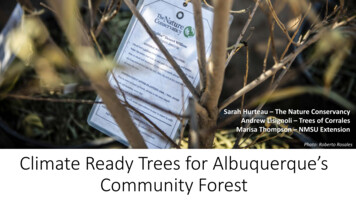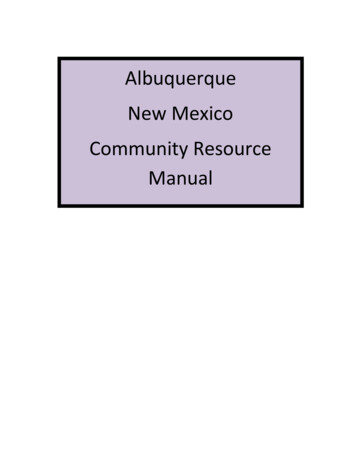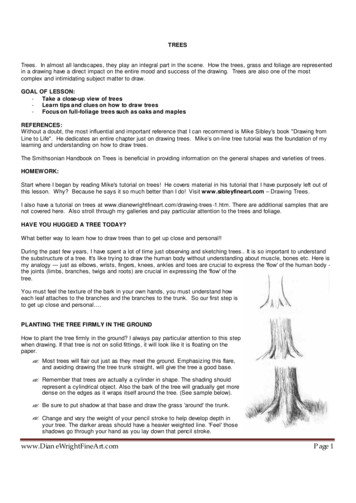
Transcription
Sarah Hurteau – The Nature ConservancyAndrew Lisignoli – Trees of CorralesMarisa Thompson – NMSU ExtensionPhoto: Roberto RosalesClimate Ready Trees for Albuquerque’sCommunity Forest
Albuquerque’s Context 200 sq miles 1.5M treesestimated 10% Canopycover Siberian Elmmost common 60% below 6” Severe heatisland
Who was Invited? Jennifer Dann, NM State Forestry Joran Viers, Albuquerque City Forester Andrew Lisignoli, Trees of Corrales Carol Bada, NM State Forestry, Tree Nursery Dr. Will Pockman, UNM Dr. Marisa Thompson, NMSU Extension Judith Phillips, Native Plant Society Amos Arbor, ABCWUA Hunter Ten Broeck, Waterwise Landscapes Dr. George Koch, Northern Arizona University
Downscaled CMIP5 Climate and HydrologyProjections RCP8.5 data from Bias-Correction SpatialDisaggregation climate monthly models Data is averaged from 39 models for thisarea over Albuquerque.In other words: We requested data from climatemodels across the globe that are utilized in the mostrecent IPCC report. The emissions scenario influencingthe climate in these models is “business as usual.”
Our ProcessPhoto: Roberto Rosales
Criteria ScoringSoil type toleranceDrought ToleranceHeat Tolerance – Next 30 Years – El PasoCold Tolerance – Next 30 Years – ABQ now2060-2099 – Tucson2060-2099 – El Paso now
Criteria ScoringExtreme Temperature Tolerance (Next 30 Years) - All scored based on USDAHardiness zones, unless species specific data is listed.Tolerance of heat 1 if Zone 8 is included or up to 105 degrees F,-1 if Zone 7 or lower, or less than 105 degrees FTolerance of cold 1 USDA hardiness zone 7 or lower (tolerant of ABQ now)-1 USDA hardiness zone 8 or higher (not tolerant of ABQ now)
Criteria ScoringExtreme Temperature Tolerance (2060-2099 )Tolerance of heat 1 if Zone 9 is included or up to 120 degrees F-1 if Zone 8 or lower or 120 degrees FTolerance of cold 1 USDA hardiness zone 8 included (tolerant of El Paso now),-1 USDA hardiness zone 9 and higher (not tolerant of Tucson now)
Criteria ScoringBonus Columns: Flooding tolerance Urban compaction tolerance Alkaline Soil Tolerance Well-drained soil requirement Pests/disease susceptibility Allergens/ Toxic parts Management requirements (pruning, tree litter, etc.) Branch attachment strength/ prone to breakage Edible parts Attractiveness (fragrance, blooms, color) Supports wildlifePhoto: Roberto Rosales
Next Steps Photo: Roberto RosalesFinalize the Climate Ready Trees ReportShare lists with local partnersOutreach to municipal departmentsLaunch Awareness Campaign in March 2020Continue to revisit criteria and let the processevolve as we learn new informationNature.org/abq
SupplyingClimate Ready Trees
How to approach lists?
Yes, this list makes me nervousWhy?Homeowners will refer to it to buy currently marginal treesLandscape Architects will specify trees currently not inproductionThis is a preliminary draft; we need to find funding to takethe next step and broaden the research parameters ofexisting studies and data
Future TreesCurrent Trials atTrees of Corrales
Growing techniques for our current conditionsWhite Washing for High Light Intensity
Ground Work Leading to ProductionSteps needed before investment into full scale Mother Block DevelopmentMarketingProduce LinersGrow Trees for Market
Celtis reticulata Net-Leaf HackberryTucson, AZSouthern UtahEastern Oregon
Celtis reticulata (Net-Leaf Hackberry)Physical Traits compiled by OSUHow do they compare to other regions?
What are the positives and negatives?Cons: Reseeds readilyQuestionable ornamental qualitiesSlow growth rateBare root transplant success unknownPros: Tolerates high light intensities, poor soil, high temperatures,flooding and drought tolerant
Are there natural hybrids?C. laevigataSugarberryC. reticulataNetleaf HackberryC. occidentalisCommon Hackberry
Production questions to answerSelection process of arboreal habitWhich root system for best transplant establishment, soil type, soilmoisture and heat.Best method to propagateTrial in various regionsDevelop Mother Block
To date how far have we come with NurseryGrown Net-Leaf Hackberry
Ulmus parvifloraChinese/Lacebark ElmCurrently in Full Nursery Production
Ulmus pumilaSiberian ElmShould this tree make the list?
My Hope for This List ofClimate Ready Trees- Motive Research leading to selections and production techniques- Motive Growers and Propagators to start the production cycle- To Start the Conversation – The Big Picture – OpportunitiesStewardship of what we haveTeachable Moments
Which road to take?
Climate Ready Trees RECAPOne of the most important urbanforest climate adaption strategiesis the planting and stewardship oftrees that are: Well-adapted to futureconditions, as well as thepresent conditions! Well-suited to Site GrowingConditions Species Diverse Planted & Mulched Properly!
How to Adapt thisClimate Ready TreesModel to Other Areas:1. Is there a city today with theclimate that is predicted for my cityin 50 (or 100) years?2. Do my favorite urban trees thrivein that other city?If not, be sure to ask why!?
What did YOU learn at Think Trees this year?What are you going to teach others?
Climate Ready Trees for Albuquerque's Community Forest Photo: Roberto Rosales Sarah Hurteau - The Nature Conservancy. Andrew Lisignoli - Trees of Corrales. Marisa Thompson - NMSU Extension. Albuquerque's Context 200 ssq mile 1.5M trees estimated 10% Canopy cover










